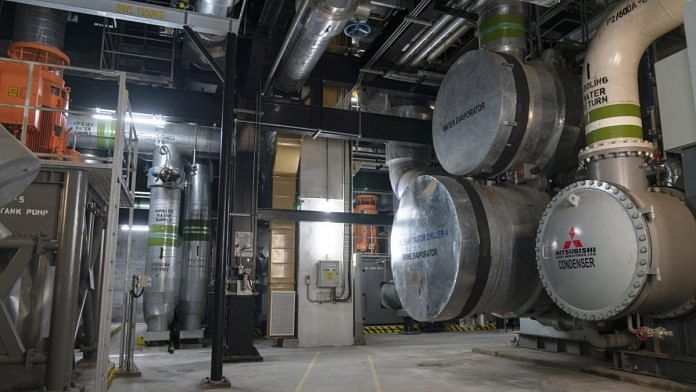Singapore: In Singapore, close to the Equator, temperatures regularly rise above 32 degrees Celsius (90 Fahrenheit) — but inside the soaring glass greenhouses of Gardens by the Bay, the country’s award-winning botanical park, it’s a pleasant 24 degrees.
The daffodils and tulips of the flower dome, along with two dozen nearby towers that are normally full of bankers, shoppers, residents, hotel guests and gamblers, are chilled by what is probably the world’s largest underground district cooling system. It’s a giant air conditioner that is attempting to solve one of the biggest problems of global warming: How to stay cool.
“As the world gets warmer, air-conditioning and refrigeration are in greater need, using up energy and emitting greenhouse gases, which in turn worsens global warming,” said Vinod Thomas, visiting professor at the Lee Kuan Yew School of Public Policy in Singapore. “This is the feedback loop we urgently need to break.”
In the past two decades, air-conditioning use has exploded, led by China, where energy demand for space cooling has grown at an average of 13% per year. That’s an increase of more than the total electricity used by the U.K. On very hot days, as much as 50% of China’s peak electricity demand is used to power air-conditioning.
Other developing countries are following. Income levels are rising in Asia, Africa and South America, and one of the first status symbols for families in hot countries who join the middle class is air-conditioning. An estimated 10 new air conditioning units will be sold worldwide every second from now to 2050. By then, around two-thirds of the world’s households could have air-con, with China, India and Indonesia accounting for half of the total, the IEA predicts.
Also read: Singapore’s future won’t look like the one before coronavirus
That means a massive drain on power — more than a third of the world’s electricity could end up being used to cool buildings and vehicles — with an equivalent jump in carbon emissions if, as is the case now, most of that extra generating capacity relies on fossil fuels.
The rise of global cooling has prompted research and development into ways to make systems more efficient using heat pumps, solar-power, evaporative coolers and other technologies. One of the most effective is to build a system that uses a large central plant that can cool several city blocks.
The largest one in the world, according to its operator, is in Singapore, where the government integrated the system and other smart city technologies for utilities and waste disposal in large underground tunnels below its new financial district before the office towers were built. Its network of pipes cools banks, residential towers, an exhibition center, shopping malls and the city’s iconic Marina Bay Sands hotel and casino complex.
Singapore needs the respite. The city-state has been warming twice as quickly as the world average over the past six decades, with temperatures rising about 0.25C per decade, partly because of the removal of forest and vegetation as the city expanded. It just had its hottest decade on record and if global carbon emissions keep rising at the current rate, daily temperatures could reach highs of 35C to 37C by 2100.
Singapore District Cooling, the unit of SP Group that runs the Marina Bay system, said that by centralizing the cooling plants, the network can save 40% of the electricity of traditional air-conditioners. With Singapore relying for most of its power on natural gas, that means an emissions saving equivalent to removing 10,000 cars from the city’s roads.
Altogether, around two dozen buildings around the Marina Bay financial district stave off the equatorial heat thanks to 5 kilometers (3.1 miles) of pipes that run five floors below the cool customers of Chanel and LVMH in the ritzy Shoppes mall on the edge of the bay.
At its heart are two plants that chill water to 4.5 degrees Celsius. To ensure the temperature is consistent, bubbles are generated to stir the water, which is then delivered to the buildings via the insulated underground pipes to cool air that is circulated through each tower. The water, now at 13C, is pumped back to the chiller and the cycle repeats. Heat from the process is released into the outside air through a large cooling tower above the ground.
While Singapore has embraced the use of rooftop solar panels and other green energy technologies, it doesn’t have the land for giant solar and wind farms and has few resources for hydropower. That’s pushed the nation to concentrate on improving the efficiency of its energy use. Next up is installing a district cooling network for a planned futuristic new town called Tengah in the west of the island, which will also include green corridors of trees and a community farm, rooftop gardens and strategically angled buildings to reduce the heat of the tropical sun. –Bloomberg
Also read: How Singapore plans to survive world’s impending food crisis






